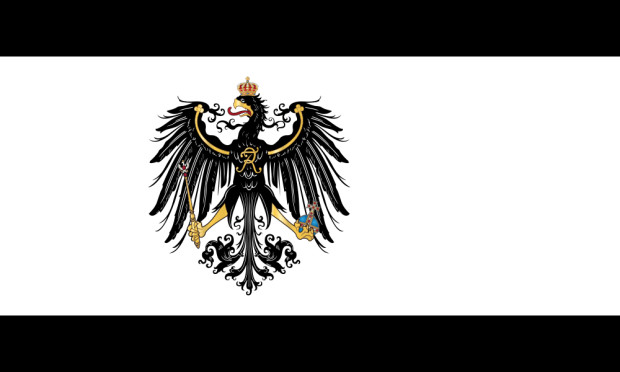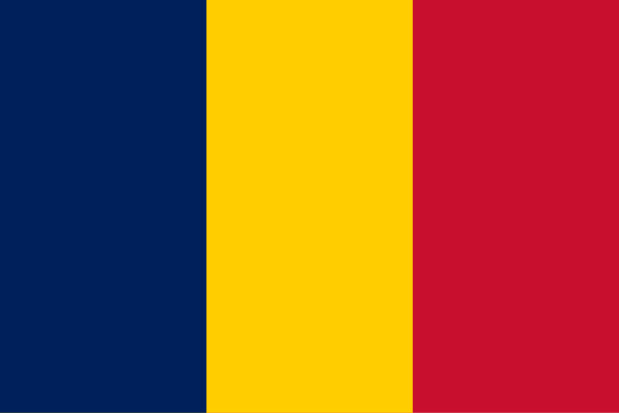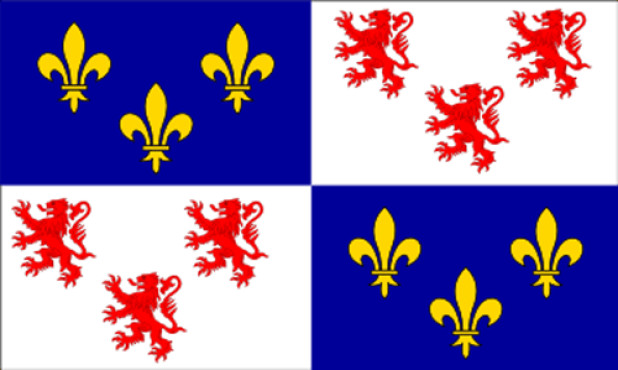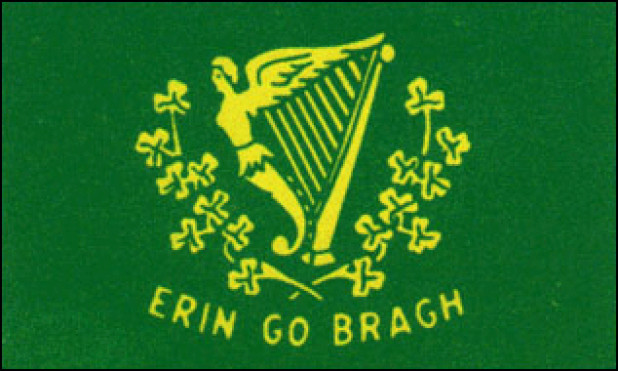Flag of Prussia (Kingdom of Prussia)

Listen to anthem
Background knowledge
The flag of Prussia featured a black eagle on a white background, which also appeared on the Prussian coat of arms. Its colors were one of the origins for the black-white-red flag of the German Empire. (Source: Qikipedia)
The colors black and white are also sung about in the song of the Prussians:
*Iam a Prussian, do you know my colors?
Theflag floats me white and black ahead;.
Thatfor freedom my fathers died,
*That,notice it, my colors indicate.
The colors black and white as the national colors of Prussia as well as the black eagle as the heraldic animal go back to the Teutonic Order in the 13th century. Thus, the knights of the Order already wore a white shield with a black cross. The important Grand Master of the Teutonic Order Hermann von Salza received the black imperial eagle as a sign of grace from Emperor Frederick II on the occasion of his appointment as Prince of the Empire in the Golden Bull of Rimini and carried it in a white shield. This was then to become the Prussian eagle coat of arms. Also the dynasty of the Hohenzollerns, which appeared in the 17th century as rulers of the Mark of Brandenburg and the Duchy of Prussia, under which the two lands grew together to form a unified Prussian state, had as a family coat of arms already in medieval times a shield "quartered by white and black".
In the Second Peace of Toruñ of 1466, Casimir IV of Poland gave the area east of the Vistula to the Teutonic Order as a fief. The rest of Prussia was ruled by the Polish king in union with the Estates and called Royal Prussia. The flag of Royal Prussia showed the black, gold-armed eagle with a red tongue on a white background. Around the neck the eagle wore a crown, in addition the eagle had an armored arm with a sword. This Prussian part of Poland existed until the first Polish partition in 1772.
Albrecht I of Brandenburg-Ansbach secularized the Teutonic Order and founded the Duchy of Prussia in the eastern part of the former state of the Order in 1525. In its flag it carried the same Prussian eagle with neck crown as the Polish part of the country, but without a sword arm, instead with a golden "S" on the chest. In 1657 the Elector of Brandenburg from the Hohenzollern dynasty, who had already ruled the Duchy of Prussia in personal union since 1618, also took over the formal sovereignty from the Polish king. Thus the duchy was absorbed into the overall state of Brandenburg-Prussia. The flag with the black eagle was flown alongside the flag of Electorate of Brandenburg with the red eagle until Prussia became a kingdom in 1701.
The flag of Elector Brandenburg first appeared on the Baltic Sea on May 1, 1657, and was the emblem of the Elector Brandenburg Navy, expanded by the Great Elector in the 1680s, which operated from the port of Pillau in East Prussia, and from which the Royal Prussian Navy emerged in 1701.
Source: Wikipedia
Meaning
The flag of the Kingdom of Prussia dates back to the royal coronation of Frederick III of Brandenburg in 1701, when the "Duchy of Prussia" became the "Kingdom of Prussia". On the flag of the Kingdom, the Prussian eagle now bore royal insignia instead of ducal insignia. It became the flag of the overall Brandenburg-Prussian state, a monarchy called "Prussia" from about the middle of the 18th century.
The flag of the kingdom was white with the crowned black Prussian eagle in the center. Its breast was adorned with the letters FR, which stood for "Fridericus Rex". Until 1750 the eagle held in its talons scepter and orb. After that, sword and a differently shaped scepter. The crown received a cross at the top. From 1801 the scepter changed again, as did the crown, and the initials FR disappeared. In 1803 the eagle changed slightly. In 1892 Prussia, by then part of the German Empire, received its last flag with black stripes above and below and a new eagle.
The various provinces into which the Kingdom of Prussia was divided from 1774 onwards each had their own flags and coats of arms, which were used alongside the Prussian ones as national emblems. The flag and coat of arms of the province of East Prussia corresponded to those of Prussia as a whole. In the coat of arms of the province of West Prussia, the old coat of arms of the "Royal Share" of Prussia annexed in 1772 (eagle with sword arm) lived on.
Source: Wikipedia
Hymn
The Prussian Song:
I am a Prussian, do you know my colors?
The flag floats before me white and black;
That for freedom my fathers died,
That, mark it, my colors indicate.
Never will I fearfully despair;
Like those I will dare
|Be it cloudy day, be it bright sunshine:
I am a Prussian, I will be a Prussian! :|
With love and loyalty I approach the throne,
From which a father speaks mildly to me;
And as the father faithful with his son,
So faithful with him do I stand, and not waver.
Firm are the bonds of love.
Hail to my fatherland!
|The king's call enters my heart:
I am a Prussian, I want to be a Prussian! :|
Not every day can glow in the sunlight;
A little cloud and a shower comes at the time.
Therefore no one reads it in my face,
That not every wish of mine shall prosper.
Many near and far have exchanged
With me many gladly;
|: Their fortune is a sham, and their freedom a pretense:
I am a Prussian, want to be a Prussian! :|
And when the evil storm wildly blows me about,
The night burns with the lightning's fire;
It has already roared worse in the world,
And what did not shake was the Prussian courage.
May rock and oak splinter,
I will not tremble;
|: It storms', it crashes', it flashes wildly in there:
I am a Prussian, I want to be a Prussian! :|
Where love and loyalty line up around the king,
Where prince and people thus join hands,
There the people's true happiness must flourish,
There the fair fatherland flourishes and grows.
So we swear anew
To the king love and loyalty!
|: Firmly be the confederation! Yes, take courage:
We are Prussians, let us be Prussians. :|
The Prussian star shall shine brightly from afar,
The Prussian eagle shall soar on the clouds,
Prussia's flag fresh laurel wreath,
Prussia's sword to victory break course.
And high on Prussia's throne
In the splendor of Frederick's crown
|: Rule us a king strong and mild,
And every Prussian breast be to him a shield! :|
That's what ChatGPT knows about the flag of Prussia (Kingdom of Prussia)
-
The historical flag of the Kingdom of Prussia, also known as the flag of the Order of the Black Eagle, was introduced in 1701 as the official symbol of the kingdom. It consisted of a white field with a black eagle bearing a red shield with a golden shield. The flag was used as a symbol of the state and a symbol of the king's authority. It was a symbol of the Prussian state and was used both at home and abroad.
-
The flag of the Kingdom of Prussia was a white and blue square, first introduced in 1701. It was used as the national flag of the Kingdom of Prussia and symbolized the unity of the Prussian state. Over the years, the flag was modified several times, but the white-blue color combination always remained. In the 19th century, the flag of the Kingdom of Prussia finally became the official flag of the German Empire.
-
The flag of the Kingdom of Prussia consisted of a white square in the center surrounded by black and white stripes. The upper half of the square was black, the lower half was white. In the center of the square was the Prussian coat of arms. The flag was introduced in 1892 and was in use until 1918. It was a symbol of the Prussian state and was used on buildings, ships and in military formations.
Discover something new
Random flags from our large flag database.






